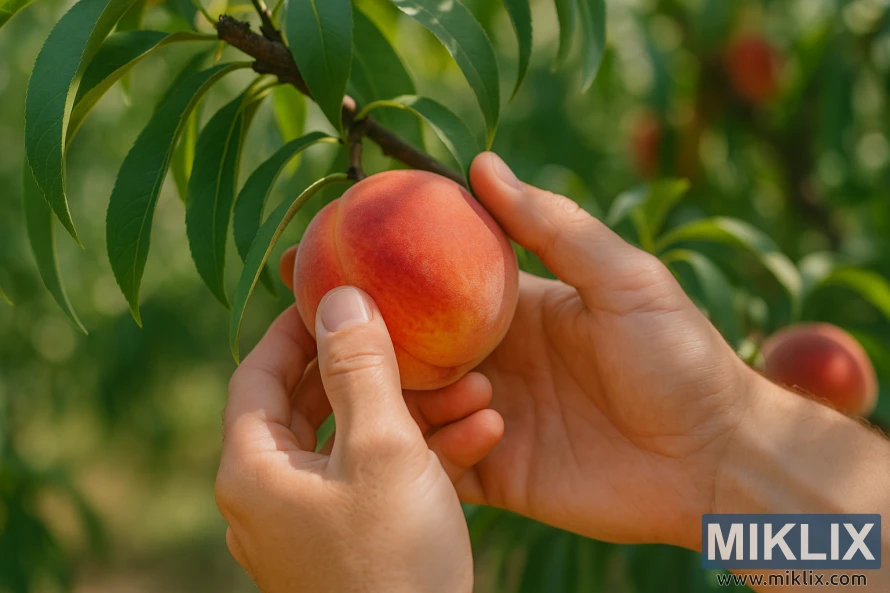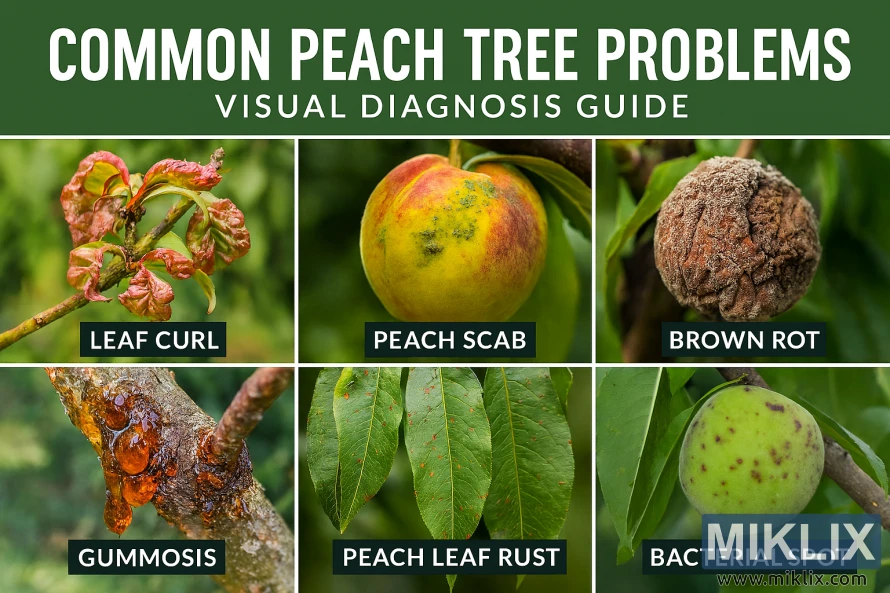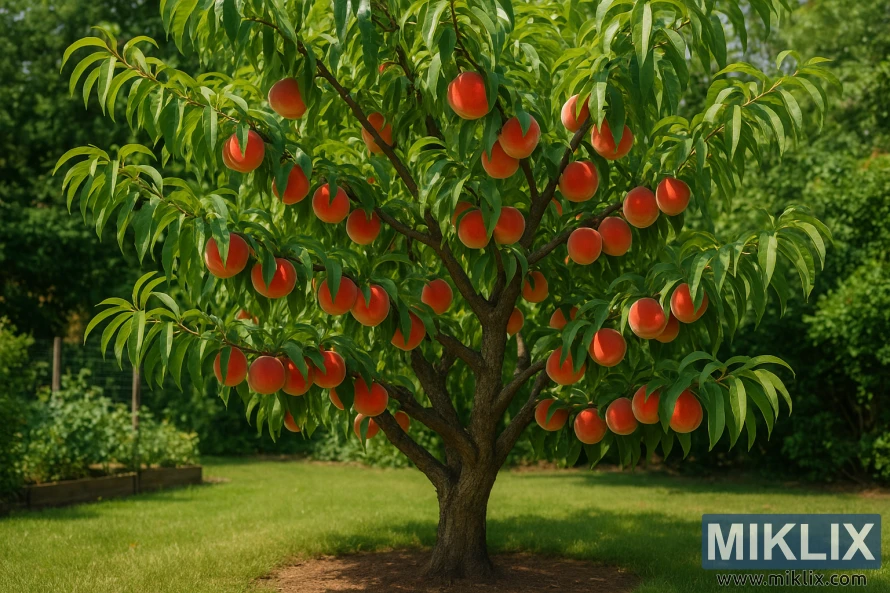How to Grow Peaches: A Guide for Home Gardeners
Published: November 24, 2025 at 12:18:51 AM UTC
There's nothing quite like biting into a sun-warmed, juicy peach you've grown yourself. With their fragrant pink blossoms in spring and sweet, succulent fruits in summer, peach trees are a rewarding addition to any home garden. While growing peaches might seem challenging, with the right knowledge and care, you can enjoy a bountiful harvest from your own backyard.

This comprehensive guide will walk you through everything you need to know about growing peaches, from selecting the perfect variety to harvesting those delicious fruits.
About Peaches
Peaches (Prunus persica) are deciduous fruit trees that originated in China, where they've been cultivated for at least 4,000 years. They belong to the same family as almonds, cherries, and plums. Peach trees typically reach 15-25 feet tall when mature, though dwarf varieties stay much smaller at 6-10 feet.
The key to growing peaches successfully is choosing varieties suited to your climate. Peach trees can be grown in USDA Hardiness Zones 4-9, but they thrive best in Zones 6-8. They require a period of winter chill (known as "chill hours") to produce fruit, with most varieties needing 600-900 hours below 45°F.
Most peach trees are self-fertile, meaning you only need one tree to produce fruit. They typically begin bearing fruit 2-4 years after planting and can remain productive for 15-20 years with proper care.
Selecting the Right Peach Variety
Choosing the right peach variety for your climate and preferences is crucial for success. Consider these factors when selecting your peach tree:
Climate Adaptation
Different peach varieties have different chill hour requirements. Chill hours are the number of hours during winter when temperatures are between 32°F and 45°F. This period of cold is essential for the tree to break dormancy and produce fruit in spring.
| Climate Zone | Recommended Varieties | Chill Hours |
| Cold (Zone 4-5) | Reliance, Contender, Hale | 800-1000 |
| Moderate (Zone 6-7) | Redhaven, Elberta, Madison | 600-800 |
| Warm (Zone 8) | Frost, Saturn, Belle of Georgia | 400-600 |
| Hot (Zone 9) | FlordaKing, Topaz, Florida Beauty | 200-400 |
Fruit Characteristics
Peaches come in different types based on their characteristics:
- Freestone vs. Clingstone: Freestone peaches have flesh that separates easily from the pit, making them ideal for fresh eating. Clingstone peaches have flesh that adheres to the pit and are often used for canning.
- Yellow vs. White Flesh: Yellow-fleshed peaches have a traditional tangy-sweet flavor, while white-fleshed varieties are sweeter with less acidity.
- Donut Peaches: Varieties like 'Saturn' and 'Galaxy' have a distinctive flattened shape and sweet white flesh.
- Dwarf Varieties: Trees like 'Bonanza' only reach 6 feet tall but produce full-sized fruit, making them perfect for small gardens or containers.
Planting Your Peach Tree
Proper planting technique for a young peach tree
When to Plant
The best time to plant peach trees is during late winter or early spring while the tree is still dormant. This gives the tree time to establish its root system before the growing season begins. In colder regions, wait until the soil has thawed and is no longer waterlogged from winter precipitation.
Choosing the Perfect Location
Location is crucial for growing peaches successfully:
- Sunlight: Peach trees need full sun – at least 6-8 hours of direct sunlight daily. Morning sun is especially important as it helps dry dew from the leaves and fruit, reducing disease problems.
- Soil: Peaches prefer well-draining, sandy loam soil with a pH between 6.0 and 6.5 (slightly acidic). Heavy clay soils can lead to root problems.
- Elevation: Plant on a slight slope or elevated area where cold air can drain away. This helps protect blossoms from late spring frosts.
- Spacing: Standard peach trees should be planted 15-20 feet apart, while dwarf varieties need 8-12 feet between trees.
- Protection: Provide shelter from strong winds, but ensure good air circulation around the tree to prevent disease.
Planting Steps
- Dig a hole twice as wide as the root ball and about the same depth.
- Create a small mound of soil in the center of the hole.
- Place the tree on the mound, spreading the roots outward.
- Position the graft union (the swollen area on the trunk) 2-3 inches above the soil line.
- Backfill with the native soil, gently tamping down to remove air pockets.
- Water thoroughly to help settle the soil.
- Apply a 2-3 inch layer of mulch around the tree, keeping it a few inches away from the trunk.
Tip: Do not add fertilizer to the planting hole as this can burn the young roots. Wait until the tree shows new growth before fertilizing.
Soil and Water Requirements
Soil Preparation
Peach trees thrive in well-draining, loamy soil. Before planting, test your soil's pH and amend if necessary to achieve a slightly acidic pH between 6.0 and 6.5. If your soil is heavy clay, improve drainage by mixing in compost, sand, or other organic matter.
Soil Amendments
- Compost: Improves soil structure and adds nutrients
- Aged manure: Adds organic matter and nutrients
- Sand: Improves drainage in heavy clay soils
- Peat moss: Helps retain moisture in sandy soils
- Sulfur: Lowers pH in alkaline soils
- Lime: Raises pH in acidic soils
Mulching Benefits
- Conserves soil moisture
- Suppresses weed growth
- Moderates soil temperature
- Adds organic matter as it breaks down
- Prevents soil compaction from rain
- Reduces competition from grass and weeds

Watering Guidelines
Proper watering is essential for peach tree health and fruit production:
- New trees: Water deeply once a week, providing about 2 gallons per tree. Increase to 3-4 gallons in sandy soils or during hot, dry periods.
- Established trees: Provide 1-2 inches of water per week during the growing season if rainfall is insufficient.
- Critical periods: Consistent moisture is especially important during fruit development and the month before harvest.
- Watering method: Drip irrigation or soaker hoses are ideal as they deliver water directly to the roots while keeping foliage dry.
- Winter watering: In dry winters, water occasionally when the soil isn't frozen to prevent root damage.
Signs of Watering Problems
Underwatering:
- Wilting leaves
- Yellowing foliage
- Leaf drop
- Small, dry fruit
- Slow growth
Overwatering:
- Yellowing leaves
- Leaf drop
- Root rot
- Fungal diseases
- Split fruit
Seasonal Care for Peach Trees
Spring Care (March-May)
- Fertilizing: Apply a balanced fertilizer (10-10-10) in early spring when buds begin to swell. For young trees, use about 1 pound; for mature trees, use 1 pound per year of age up to 10 pounds maximum.
- Pest control: Apply dormant oil spray just before buds break to control overwintering pests.
- Blossom thinning: If late frosts threaten, protect blossoms with frost cloth or spray trees with water before sunrise.
- Fruit thinning: When fruits reach the size of a quarter (usually 3-4 weeks after bloom), thin them to one fruit every 6-8 inches along branches.
Summer Care (June-August)
- Watering: Maintain consistent moisture, especially as fruits develop.
- Summer pruning: Remove any vigorous upright shoots that shade the center of the tree.
- Pest monitoring: Check regularly for signs of pests and diseases, treating promptly if found.
- Harvesting: Pick fruits when they separate easily from the branch with a gentle twist.
Fall Care (September-November)
- Clean-up: Remove all fallen fruit and leaves to reduce disease pressure.
- Late fertilizing: Avoid fertilizing after midsummer to prevent stimulating late growth.
- Mulching: Apply fresh mulch around the base of the tree, keeping it away from the trunk.
- Watering: Continue watering until the ground freezes if rainfall is insufficient.
Winter Care (December-February)
- Dormant pruning: Prune during late winter before buds swell to shape the tree and remove dead or diseased wood.
- Winter protection: In cold regions, wrap the trunk with tree wrap to prevent sunscald and rodent damage.
- Dormant sprays: Apply copper-based fungicide to control diseases like peach leaf curl.
- Planning: Order new trees if needed and prepare for spring planting.

Pruning and Training Peach Trees
Properly pruned peach tree with open-center form
Pruning is essential for peach trees. Unlike some fruit trees that can be left unpruned, peaches require annual pruning to remain productive. Peaches produce fruit on one-year-old wood (branches that grew the previous season), so proper pruning encourages new growth for the next year's crop.
Pruning Goals
- Create an open-center or vase shape to allow sunlight to reach all parts of the tree
- Remove dead, diseased, or damaged wood
- Encourage new fruiting wood
- Maintain tree height for easier harvesting
- Improve air circulation to reduce disease problems

When to Prune
The best time to prune peach trees is in late winter just before bud break. Unlike most fruit trees that are pruned during full dormancy, peach trees should be pruned as late as possible before spring growth begins. This reduces the risk of winter injury and allows you to identify and remove any cold-damaged wood.
Pruning Technique
For established trees, follow these steps:
- Remove any dead, diseased, or damaged branches first.
- Cut out any branches growing toward the center of the tree.
- Remove any suckers growing from the base of the tree or water sprouts growing straight up from branches.
- Thin out crowded areas to improve air circulation.
- Shorten branches that are too tall, cutting back to an outward-facing bud.
- Remove about 40% of the previous season's growth to stimulate new fruiting wood.
Tip: Always use clean, sharp pruning tools to make clean cuts that heal quickly. Disinfect tools between trees with a 10% bleach solution or 70% alcohol to prevent spreading diseases.

Managing Pests and Diseases
Common peach tree problems: leaf curl, brown rot, borers, and aphids
Peach trees can be susceptible to various pests and diseases, but many problems can be prevented or managed with proper care. Here are the most common issues and how to address them organically:
Common Diseases
| Disease | Symptoms | Organic Treatment | Prevention |
| Peach Leaf Curl | Reddish, puckered, distorted leaves in spring | Copper fungicide during dormancy | Apply copper spray in late fall and before bud break |
| Brown Rot | Brown, fuzzy spots on fruit; mummified fruit | Sulfur spray during flowering and fruit development | Remove all mummified fruit; improve air circulation |
| Bacterial Spot | Small dark spots on leaves and fruit | Copper spray early in season | Plant resistant varieties; avoid overhead watering |
| Powdery Mildew | White powdery coating on leaves | Neem oil or potassium bicarbonate spray | Proper pruning for air circulation; avoid excess nitrogen |
Common Pests
| Pest | Symptoms | Organic Treatment | Prevention |
| Peach Tree Borer | Gummy ooze at base of trunk; weakened tree | Beneficial nematodes; manually remove larvae | Maintain tree vigor; apply kaolin clay to trunk |
| Aphids | Curled leaves; sticky honeydew | Insecticidal soap; neem oil | Encourage beneficial insects; avoid excess nitrogen |
| Oriental Fruit Moth | Tunneling in fruit and twig tips | Bacillus thuringiensis (Bt); pheromone traps | Timely harvest; remove fallen fruit |
| Japanese Beetles | Skeletonized leaves | Hand pick; milky spore in soil | Row covers during beetle season |
Organic Spray Schedule
For organic peach growing, follow this basic spray schedule:
- Late fall (after leaf drop): Copper fungicide for leaf curl and bacterial spot
- Late winter (before bud break): Dormant oil for overwintering insects; copper spray for diseases
- Pink bud stage: Sulfur spray for brown rot
- Petal fall: Neem oil for insects; sulfur for diseases
- Shuck split (when remnants of flowers fall off): Kaolin clay for insects
- Three weeks before harvest: Final sulfur spray for brown rot (observe pre-harvest intervals)
Organic Pest Control Kit
Get everything you need for organic peach tree protection in one convenient package:
- Dormant oil spray
- Copper fungicide
- Neem oil concentrate
- Kaolin clay
- Sulfur spray
- Detailed application guide

Harvesting and Enjoying Your Peaches
When to Harvest
Knowing when to pick peaches is crucial for the best flavor. Depending on the variety, peaches typically ripen from late June through August. Here's how to tell when they're ready:
- Color: The background color should change from green to yellow or cream (ignore the red blush, as it can appear before the fruit is ripe).
- Feel: Ripe peaches yield slightly to gentle pressure but aren't mushy.
- Aroma: Ripe peaches have a sweet, fragrant smell.
- Ease of picking: A ripe peach will come off the branch with a gentle twist.
How to Harvest
To harvest peaches without damaging them:
- Cup the peach in your palm, avoiding pressure from your fingers.
- Gently twist and pull the fruit from the branch.
- Place harvested peaches carefully in a shallow container to avoid bruising.
- Handle peaches by their "shoulders" rather than squeezing the middle.

Storing Your Harvest
- Short-term storage: Ripe peaches can be kept at room temperature for 1-2 days.
- Refrigeration: Store ripe peaches in the refrigerator for up to 5 days.
- Ripening: To ripen slightly underripe peaches, place them in a paper bag at room temperature.
- Freezing: Slice peaches, treat with lemon juice or ascorbic acid to prevent browning, and freeze on a tray before transferring to freezer bags.
- Canning: Process peaches in a water bath canner for long-term storage.

Enjoying Your Peaches
There are countless ways to enjoy your homegrown peaches:
- Fresh eating: Nothing beats a perfectly ripe peach eaten out of hand.
- Baking: Peach cobbler, pie, crisp, or muffins showcase the fruit's sweet flavor.
- Preserves: Make peach jam, butter, or chutney to enjoy year-round.
- Grilling: Halved peaches caramelize beautifully on the grill for a summer dessert.
- Freezing: Freeze sliced peaches for smoothies and desserts throughout the year.
- Savory dishes: Add peaches to salads or pair with grilled meats for a sweet contrast.
Troubleshooting Common Problems
Why isn't my peach tree producing fruit?
Several factors can cause lack of fruit production:
- Age: Young trees (under 3 years) may not produce yet.
- Insufficient chill hours: The variety may need more winter chill than your climate provides.
- Late frost: Spring frosts can kill blossoms before fruit sets.
- Improper pruning: Removing too much one-year-old wood eliminates fruiting sites.
- Poor pollination: While peaches are self-fertile, they still need pollinators or gentle shaking during bloom.
- Solution: Select appropriate varieties for your climate, protect from late frosts, prune correctly, and encourage pollinators.
Why are my peach tree's leaves yellowing?
Yellowing leaves can indicate several issues:
- Nutrient deficiency: Especially iron or nitrogen.
- Overwatering: Soggy soil can cause root problems and yellowing leaves.
- Underwatering: Drought stress can cause yellowing and leaf drop.
- Pests: Sucking insects can cause yellowing.
- Disease: Several fungal and bacterial diseases cause yellowing.
- Solution: Check soil moisture and drainage, test soil for nutrient deficiencies, inspect for pests, and treat accordingly.
Why are my peaches small or dropping prematurely?
Small or dropping fruit can be caused by:
- Lack of thinning: Too many fruits competing for resources.
- Water stress: Inconsistent watering during fruit development.
- Nutrient deficiency: Especially potassium or phosphorus.
- Pest damage: Insects like plum curculio can cause fruit drop.
- Disease: Brown rot and other diseases can affect fruit development.
- Solution: Thin fruits properly, maintain consistent watering, fertilize appropriately, and monitor for pests and diseases.
Why do my peaches have split pits or cracked fruit?
Split pits and cracked fruits are often related to growing conditions:
- Inconsistent watering: Fluctuations between dry and wet periods.
- Rapid growth: Excessive nitrogen or sudden growth spurts.
- Weather: Heavy rain following dry periods can cause fruit to crack.
- Variety susceptibility: Some varieties are more prone to these issues.
- Solution: Maintain consistent soil moisture, avoid excessive nitrogen fertilization, and consider mulching to regulate soil moisture.

Conclusion
Growing peaches in your home garden can be incredibly rewarding. While it requires attention to detail and regular care, the sight of pink blossoms in spring and the taste of sun-ripened fruit in summer make it all worthwhile. By selecting the right varieties for your climate, providing proper planting and care, and staying vigilant against pests and diseases, you can enjoy bountiful harvests of delicious peaches for many years.
Remember that each growing season brings new learning opportunities. Don't be discouraged by challenges—even experienced orchardists face setbacks. With patience and persistence, you'll develop the skills needed to grow magnificent peaches that far surpass anything you can find in a grocery store.
So dig in, get your hands dirty, and start your peach-growing adventure. Your future self will thank you when you're biting into that first perfect, homegrown peach!

Further Reading
If you enjoyed this post, you may also like these suggestions:
- The Healthiest Berries to Grow in Your Garden
- The Best Fruit Trees to Plant in Your Garden
- The Best Cherry Varieties to Grow in Your Garden
